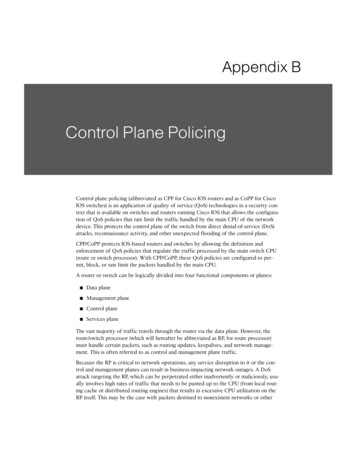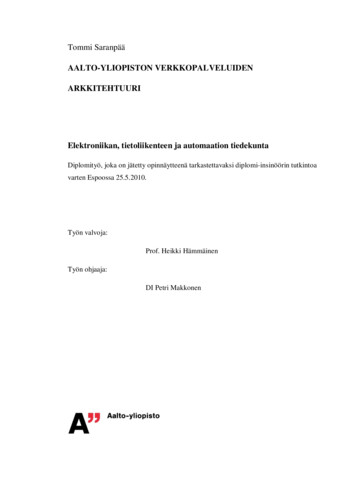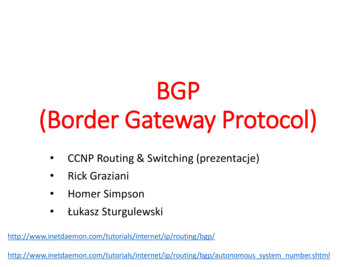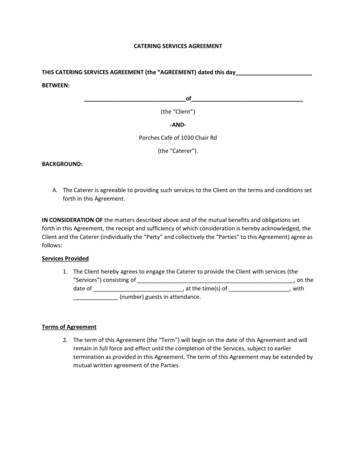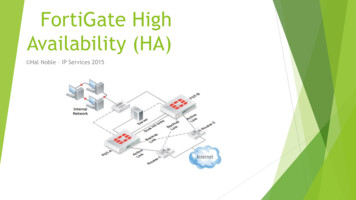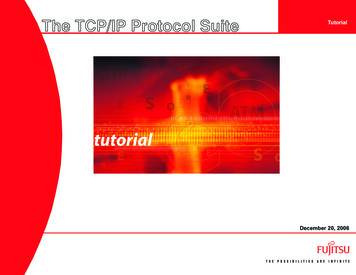![State Protocol Agreement Between The Colorado State Director [Sd] Of .](/img/43/co-20protocol.jpg)
Transcription
STATE PROTOCOL AGREEMENT BETWEENTHE COLORADO STATE DIRECTOR [SD] OF THE BUREAU OF LANDMANAGEMENT [BLM] AND THE COLORADO STATE HISTORIC PRESERVATIONOFFICER [SHPO] REGARDING THE MANNER IN WHICH THE BLM WILL MEET ITSRESPONSIBILITIES UNDER THE NATIONAL HISTORIC PRESERVATION ACT[NHPA] AND THE 2012 NATIONAL PROGRAMMATIC AGREEMENT [National PA]AMONG THE BLM, THE ADVISORY COUNCIL ON HISTORIC PRESERVATION[ACHP], AND THE NATIONAL CONFERENCE OF STATE HISTORICPRESERVATION OFFICERS [NCSHPO]I. INTRODUCTIONA. This State Protocol Agreement [Protocol] supplements the National PA, anddescribes how SHPO and BLM will interact. This Protocol emphasizes a collaborative andcooperative relationship, while striving to improve the management of cultural resourceson BLM lands in Colorado and those that might be affected by BLM’s actions. It alsoensures a program for continued and enhanced communication between BLM, SHPO,Indian tribes, and other consulting parties potentially affected by BLM undertakings.B. This Protocol replaces the 1998 Protocol, which is hereby terminated except asstipulated in Section II (A), and provides for alternative procedures for implementingSection 106, as well as setting forth requirements pursuant to Section 110 of the NHPA.C. This Protocol does not change the consultation requirements with Indian tribes andthe public required in the National PA.D. Terms used in this Protocol are defined in Attachment A. All other terms notspecifically defined in Attachment A remain as defined in 36 CFR 800.16.E. This Protocol streamlines Section 106 requirements for consultation with SHPO forundertakings, and contains stipulations regarding proactive Section 110 managementprograms, maintenance of field office cultural resource project logs, field office reviewsand certification, annual reviews, annual reports, and cultural resource staffqualifications.F. BLM is legally responsible for carrying out undertakings consistent with the NHPAand the National Environmental Policy Act [NEPA].G. BLM National Landscape Conservation System [NLCS] units are organized underfield offices with assigned cultural resource specialists, and are included when fieldoffices are referenced below.1
II. RELATIONSHIP OF THIS PROTOCOL WITH OTHER AGREEMENTSA. Addendum I to the 1998 Protocol, entitled “Section 106 Requirements forComprehensive Travel and Transportation Management”, along with the 1998 Protocol,is appended as Attachment F to this Protocol. Attachment F will apply to all land useplanning efforts initiated and involved in the consultation process at the time this Protocolis executed. The content of Addendum 1 will be updated within two years, and the newcontent will be added to Attachment E. Attachment F will be removed with the mutualagreement of the parties without formal amendment to this Protocol.B. When additional statewide agreement documents are needed to define proceduresthat are not covered by the National PA or this Protocol, BLM and SHPO may develop, inconsultation with Indian tribes and other interested parties, other statewide PAs,Memoranda of Agreement [MOA] and Instruction Memoranda [IM], and will append thesupplemental agreements to Attachment E of this Protocol.III. WHEN BLM WILL USE 36 CFR PART 800A. In certain circumstances, the alternative procedures detailed in this Protocol may besuspended. The regulations at 36 CFR 800.3 through 800.7, 36 CFR 800.8(c), 36 CFR800.14, or the subparts detailed in each item below, will be followed in lieu of this Protocolfor the following:1. Emergency undertakings, pursuant to 36 CFR 800.12;2. When ACHP formally participates in adverse effects resolutions, pursuant to 36CFR 800.6(b)(2) or 800.14(b);3. All multi-state projects;4. When an undertaking will adversely affect a National Historic Landmark (NHL);5. If a field office is decertified;6. When BLM develops program alternatives, including project-specific PAs,pursuant to 36 CFR 800.14;7. If BLM or SHPO terminates this Protocol;8. If the National PA is terminated or suspended;9. If SHPO and BLM fail to reach agreement on National Register of Historic Places[NRHP] eligibility, effect, or effect resolutions, pursuant to 36 CFR 800.4(c)(1)-(2), or 36CFR 800.4(d)(1)(ii)-(iii), or 36 CFR 800.5(c)(2)(i)-(iii), or 36 CFR 800.6.2
B. In the case of complex or controversial undertakings, BLM and SHPO may consult todetermine whether the regulations would serve as the appropriate compliancemechanism.IV. ADMINISTRATIVE INTERACTION AND REPORT PROCEDURESA. Administrative Reports1. BLM’s “Cultural Resource Management Program Annual Report,” which issubmitted to the Washington Office for the Secretary of the Interior’s “Report to Congresson Federal Archaeological Activities”, will serve as BLM’s Annual Report to SHPO[Annual Report].2. The Annual Report covers a twelve month period, from August 1 through July 31.3. BLM will submit the Annual Report to SHPO in September and will simultaneouslypost it on the BLM Colorado website. BLM will notify ACHP and SHPO, by email, of theonline availability of the report. This report, without locational and funding information, willalso be available to the public and to Indian tribes.4. SHPO may prepare a response that assesses the effectiveness of BLM'simplementation of this Protocol and may make recommendations for actions to be takenby BLM. SHPO will submit the response to BLM within 30 days of receiving the AnnualReport. BLM will consider SHPO’s assessments and recommendations for futureactions and will respond, as appropriate, within 30 days. If SHPO is not satisfied withBLM’s response, the parties will follow dispute resolution procedures detailed in SectionXVI (A).5. By August 1, each BLM field office will provide the BLM Deputy PreservationOfficer for Colorado [DPO] with an updated and complete cultural resources project log,as described in the following section, enclosing the project log with the Annual Report.B. Field Office Cultural Resource Project Log [CR Log]1. Each BLM field office will maintain a CR log for the period from August 1 throughJuly 31, every year.2. In the CR log, the field office will list both undertakings that require formal SHPOcorrespondence (concurrence and informational letters) and undertakings that do notrequire formal SHPO correspondence (such as literature and record searches forproposed undertakings and exemptions).3. In the CR log, BLM will also list Section 110 activities that resulted in units ofaccomplishment tracked in the BLM Performance Management Data System.3
4. At a minimum, BLM will include the following in the CR log: Name of undertaking or Section 110 activityType of undertaking or Section 110 activityNEPA number (if assigned)BLM cultural resource numberSHPO number (if assigned)Final SHPO correspondence date (if appropriate)5. Information requirements in the field office CR log may be amended followingmutual agreement between the DPO and SHPO, and the amended requirements will beappended to this Protocol.6. BLM will clearly indicate undertakings with documentation backlogs in the CR log.7. If questions or concerns about an undertaking arise, the DPO or SHPO mayreview a field office CR log at any time.8. The field office will provide an updated and complete CR log to the DPO andSHPO prior to a field office review.9. If SHPO desires more information about an undertaking, it may access onlineBLM NEPA documents. A log of pending undertakings for each field office [NEPA log] isavailable online at http://www.blm.gov/co/st/en/BLM Information/nepa.html at present,however, this web address might change in the future. If necessary, SHPO will contactan individual field office to determine the most current online location of its NEPA log.10. BLM will pursue the development of an electronic method for disseminating CRlog information.C. Meetings1. SHPO and BLM will meet regularly to facilitate good communications. Suchmeetings may be conducted face-to-face, by video-conferencing, or by use of otherlong-distance meeting technology.2. SHPO staff, the DPO, and BLM cultural resource staff from each district will meetannually to review the implementation of this Protocol and to discuss pertinent issues.3. SHPO staff and the DPO will meet quarterly to discuss current Section 106compliance issues and to exchange information relevant to the goals and objectives setforth in this Protocol.4. The parties may arrange other meetings to address emerging issues and theireffects on cultural resources.4
V. SHPO INVOLVEMENT IN BLM LAND USE PLANNINGA. BLM will notify SHPO of opportunities to participate at the development stage and allsubsequent phases of land use planning in accordance with 43 CFR 1610.3(“Coordination with Other Federal Agencies, State and Local Governments, and IndianTribes”).1. During public scoping, BLM will initiate a conference call with SHPO to introduce aland use plan, identify interested public, discuss cultural resource issues and concerns,and to determine a review schedule.2. BLM will provide SHPO with the most current land use plan (e.g., resourcemanagement plan) and amendments, along with cultural resource management plans foreach field office. SHPO may access the associated NEPA documents online throughthe NEPA log of a field office, if available.B. BLM cultural resource goals and objectives in land use plans will consider andincorporate the objectives and strategies identified in the current Office of Archaeologyand Historic Preservation [OAHP] state preservation plan, when relevant.VI. COOPERATIVE PROGRAM DEVELOPMENT ACTIVITIESA. Shared Database and Information Management1. In order to enhance understanding of Colorado’s past, provide a resource foreducation, and permanently preserve information that otherwise will be lost, SHPO andBLM will continue to exchange information and work cooperatively regarding the location,evaluation, and management of cultural resources in Colorado. Such informationincludes, but is not limited to: geospatial data, reports, site and isolated find forms, andmaps.2. SHPO and BLM will work expeditiously and cooperatively to resolve data errorsfound in formal documentation and in the SHPO database.3. Although digital data are the preferred format for exchange, BLM and SHPO willensure that hard copy information, in reasonable amounts, will be available. A datasharing cooperative agreement administered by the BLM Colorado State Office willgovern the exchange of information, and the parties will review and update the agreementevery three years or when needed.4. BLM will maintain and annually update a Digital Specifications Guide [Guide] thatdetails the specifics of the information exchange. Before the release of the Guide eachyear, BLM will request input from the field office staff and a review of the document bySHPO’s information management staff. An electronic copy of the Guide will be availableon the BLM and SHPO websites.5
5. SHPO will continue to manage an automated database with geospatialcapabilities, and will populate the database with information supplied, in part, by BLM.As the primary repository for such information in Colorado, SHPO will migrate thearchived digital data as new technologies are developed. BLM will assist SHPO inmaintaining and improving the information system by providing financial, personnel,hardware, and software resources, as funding is available.6. BLM will serve as a partner in the development of the statewide system that will beused to synthesize cultural resources information. As available and feasible, BLM willsupply the resources enumerated in Section VI(A)(5).7. BLM and SHPO will review and analyze the information exchange system andbest practices for cultural resources information management annually, prior to release ofthe Guide.8. BLM and SHPO will implement the following data security measures:a. Both parties will ensure that all sensitive information is protected fromunauthorized use;b. Both parties will investigate the circumstances of any geospatial or sensitivedata breach and will cooperatively develop remedies that can be implemented byeach agency. BLM and SHPO will together determine the best course of action toretrieve and secure the information.B. Section 110 Program Management Activities1. Each BLM field office will develop, implement, and maintain a Section 110management program that incorporates one or more of the following activities:a. Heritage resources education and outreach, such as on-site and off-siteinterpretation, education programs, brochures, posters, exhibits, electronicapplications, web pages, presentations, and site tours;b. Proactive inventory of public lands for planning and research, to determine thepresence and importance of cultural resources;c. Intensive documentation, evaluation and study of cultural resources and historicstructures, such as nominations to the NRHP, condition assessments, oral historystudies, cultural landscape studies, regional overviews, historic contexts, andartifact or specimen analysis;d. Stabilization, management, restoration, and protection of cultural resources andhistoric structures, such as brick and mortar stabilization and installation of fences,gates and anti-vandalism signs;6
e. Monitoring of cultural resources and historic structures to assess resourcecondition and to detect and deter looting and vandalism.2. BLM and SHPO will cooperatively participate in Archaeology and HistoricPreservation Month and other historic preservation activities sponsored by HistoryColorado.3. BLM will utilize cooperative stewardship and cost-share projects and programswith partners, where feasible, including field schools, site steward programs and othervolunteer programs.4. Each BLM field office will list Section 110 activities and accomplishments in theCR log.5. If BLM produces formal documentation for a Section 110 activity, it will submit thedocumentation to SHPO with an informational letter.C. Emerging Issues1. BLM or SHPO may identify issues or subject areas that require policy changes orprocedures not detailed in this Protocol. The parties will consult and determine whetherthe issues or subject areas require further analysis by a working group.2. At a minimum, the working group will include the DPO, field office culturalrepresentatives and SHPO representatives. The DPO will invite field office culturalresource representatives that are interested in participating, along with those thatpossess skills or knowledge which would benefit the process. The field managers willapprove the participation of their staff.3. The working group will produce recommendations to be reviewed by BLM, SHPOand other consulting parties that possess an interest in the outcome, and will take theresulting comments into account when finalizing new policies and procedures.4. BLM will formalize as addenda to this protocol any new policies and/or proceduresdeveloped by the working group, and approved by BLM in consultation with SHPO. BLMwill place addenda in Attachment E and will number them consecutively.VII. NATIVE AMERICAN PARTICIPATIONA. BLM will consult with Indian tribes on individual undertakings as part of ongoinggovernment-to-government relationships, sustained by regular consultation, on aprogrammatic basis. BLM field managers will make the final determination on the Indiantribes to be consulted for an undertaking. BLM will seek to develop Protocol agreementswith Indian tribes. In consulting with Indian tribes or authorized tribal representatives,BLM will follow 36 CFR 800.2(c)(2) and will use the following guidance:7
BLM Manual 8120, Tribal Consultation under Cultural Resource AuthoritiesBLM Handbook H-8120-1, Guidelines for Conducting Tribal ConsultationExecutive Order No. 13007, Indian Sacred SitesExecutive Order 13175, Consultation and Coordination with Indian TribalGovernmentsNational Register Bulletin 38: Guidelines for Evaluating and DocumentingTraditional Cultural Properties2011 DOI Tribal Consultation Policy and Companion Secretarial Order 3317Tribal Protocols/Memoranda of Understanding for consultation, as developedB. Consultation with Tribes1. Tribal consultation applies to identification, evaluation, and effects resolutionactivities conducted under this Protocol.2. BLM will seek and consider the views of an Indian tribe that attaches religious andcultural significance to cultural resources within the area of potential effect [APE] of anundertaking.3. Field managers will ensure that consultation with Indian tribes takes place at theearliest stages of planning.4. As needed, field managers will continue consultation throughout the planning andimplementation stages of an undertaking.5. A NEPA log listing pending undertakings for each field office is available online forthe use of interested Indian tribes [see Section IV (B) (9)].C. Native American Human Remains1. If Native American human remains, funerary objects, sacred objects, or objects ofcultural patrimony are encountered as a result of a BLM undertaking, BLM will complywith Section 3 of the Native American Graves Protection and Repatriation Act [NAGPRA]and its implementing regulations at 43 CFR Part 10, Subpart B.2. BLM will follow the provisions of applicable Colorado state law regardingUnmarked Human Graves (CRS 24-80-1302) for human remains discovered on state orprivate lands in Colorado.VIII. OTHER CONSULTING PARTIESA. Other consulting parties include local governments, grantees, permittees, andowners of affected lands or land surfaces. Consulting parties may also include localhistorical societies, historic preservation advocacy groups, or certain individuals andorganizations with a demonstrated interest in the undertaking (36 CFR 800.2 (c) (5).8
B. BLM will invite consulting parties to participate in the Section 106 consultationprocess [Section VIII (C)] if they have a demonstrated interest in a BLM undertaking andits effects on historic properties.1. BLM will consider the nature of the undertaking when determining appropriateconsulting parties.2. BLM will consult SHPO Publication 1568, which lists local governments withhistoric preservation ordinances or resolutions, and upon request, SHPO will shareinformation with BLM regarding possible consulting parties for an undertaking.3. BLM field managers will make final determinations regarding consulting partyparticipation for each undertaking.C. Consultation Activities1. BLM will confer with consulting parties regarding identification, evaluation, andeffects resolution activities conducted under this Protocol.2. Field managers will ensure that consultation takes place at the earliest stages ofplanning.3. As needed, field managers will continue consultation throughout the planning andimplementation stages of an undertaking.D. BLM may elect to coordinate its Section 106 consulting party obligation with its NEPApublic participation requirement, recognizing that the Section 106 consultationrequirement differs somewhat from the NEPA public involvement procedures. Possiblemethods for this coordination include, but are not limited to:1. Inserting language into the NEPA scoping notification (including Notices of Intent)indicating that the notification partially fulfills Section 106 consultation requirements;2. Ensuring that public contacts and scoping meetings include information aboutSection 106 consultation;3. Referencing a related Section 106 MOA or PA in an appendix of the draft and finalNEPA document (while protecting sensitive cultural resource information).E. In the NEPA document sections on affected environment, impacts, and mitigation,BLM will include only non-proprietary information obtained during the Section 106process.9
IX. PUBLIC PARTICIPATIONA. BLM will seek and consider the views of the public for purposes of Section 106 whencarrying out the actions under the terms of this Protocol, pursuant to 36 CFR 800.2(d)(3).B. BLM will solicit input through the public participation opportunities afforded by BLM’sland use planning and environmental review processes established under NEPA and theFederal Land Policy and Management Act (FLPMA), and in accordance with regulationsfor Coordination of Planning Efforts at 43 CFR 1610.3.C. BLM will follow internal guidance regarding the coordination of NEPA and NHPArequirements, including Washington Office IM 2012-108, until that IM is superseded bypolicy or until an updated reissuance of IM 2012-108 is available.D. In order to allow an opportunity for the public to comment on BLM undertakingssubject to Section 106 review, each field office currently maintains a log of pendingundertakings (the NEPA log). At present the NEPA log is available online athttp://www.blm.gov/co/st/en/BLM Information/nepa.html. The public and interestedparties may contact the individual field office for further information.E. When the public has a stake in the effect of a BLM undertaking on historic properties,BLM will notify and invite them to consult in the review process pursuant to NHPA.F. This Protocol governs compliance with the NHPA, specifically the relationship of BLMand SHPO, and does not replace BLM’s other responsibilities to the public under otherauthorities.X. IDENTIFICATION, EVALUATION, AND RESOLUTION OF EFFECTSA. BLM will carry out all activities in this section in consultation with Indian tribes andconsulting parties, as appropriate.B. Routine Undertakings: Routine undertakings do not require formal consultation withSHPO. The following situations are considered routine, and BLM does not need to waitfor SHPO concurrence with its determinations of NRHP eligibility and effect:1. When an undertaking qualifies as an exemption (see Attachment B);2. When no cultural resources are identified in the APE;3. When cultural resources are present in the APE, but only when the determinationsof effect are either “No historic properties affected” or “No adverse effect”.10
C. Non-Routine Undertakings: Non-routine undertakings require formal consultationwith SHPO and may require ACHP notification, depending on the classification below.Such undertakings may not proceed until BLM completes Section 106 consultation withSHPO, Indian tribes and other consulting parties. Lists of non-routine undertakings,organized by their required consultation levels, follow.1. The following undertakings and situations meet the threshold for formal SHPOconsultation:a. Land exchanges, land sales, and land transfers to non-federal entities;b. Recreation and Public Purpose Act leases;c. Geophysical operations involving surface disturbance;d. Undertakings adversely affecting historic properties;e. Undertakings involving NHLs;f. Undertakings involving landowner denial of access to the APE;g. NRHP eligibility determinations regarding traditional cultural properties;h. When BLM’s cultural resource specialists wish to bring a particular project tothe attention of SHPO.2. The following undertakings and situations meet the threshold for ACHPnotification:a. Non-routine interstate and/or interagency projects or programs;b. Undertakings adversely affecting NHLs;c. Undertakings that BLM determines to be highly controversial (e.g.,undertakings that receive unusual public attention and/or involve conflict);d. Undertakings that will have an adverse effect on historic properties andcannot be resolved through formal agreement between BLM and SHPO (suchas an MOA or PA);e. The development and approval of program alternatives, includingproject-specific PAs.11
3. General Provisions Regarding ACHP Involvementa. BLM will invite ACHP to participate in consultation following the guidelinesat 36 CFR 800.11(e) when undertakings meet the thresholds listed in Section X(C) (2), and will follow the processes at 36 CFR 800.6(b)(2) or 800.14(b) toresolve adverse effects when ACHP formally participates in the resolution ofadverse effects for an undertaking.b. ACHP may enter into consultation at any time, pursuant to Section 5 (d) ofthe National PA.c. At any point in the Section 106 process, BLM, SHPO, or other consultingparties may request the ACHP’s guidance or participation, but ACHP willdetermine whether it elects to participate.D. Exemptions. Undertakings that have little or no potential to affect historic properties,for which no identification is necessary, are identified in Attachment B. Exemptions aredefined as routine undertakings, and may proceed without further consultation withSHPO. BLM will submit no formal documentation to SHPO, but will note the use of theexemption in the CR log.1. BLM cultural resource specialists will review proposed undertakings to determinewhether a specific project or activity qualifies as an exemption, as described inAttachment B and in BLM Manual 8110.23 (“Survey Requirements and Exceptions”).Only BLM professional staff, as described in Section XIV(A)(2)(c), are authorized todetermine whether the undertaking is an exempted project or activity.2. In consultation with Indian tribes and other consulting parties, BLM and SHPOmay agree that other classes of exempted undertakings may be revised withinAttachment B without formally amending this Protocol.E. Area of Potential Effects1. BLM cultural resource specialists will determine the APE of an undertaking, asdefined by 36 CFR 800.16(d), taking into account information provided by Indian tribes,consulting parties and interested parties, as appropriate.2. BLM will fully document the APE in the inventory report.3. BLM may request the assistance of SHPO when defining the APE of anundertaking. If the definition of the APE has the potential to cause controversy, BLMmay choose to consult with SHPO in writing. In such circumstances, BLM will provideSHPO with documentation, such as maps and literature review information, along with aformal written request to consult. SHPO will respond to BLM in writing within ten workingdays.12
F. Identification of Historic Properties1. During the earliest feasible planning stage of an undertaking, BLM will seek outinformation needed to identify historic properties within the APE including: Consultation with Indian tribes and consulting parties, as appropriate;The BLM Colorado Handbook of Guidelines and Procedures for Inventory,Evaluation, and Mitigation of Cultural Resources [Handbook]; andRelevant ACHP guidance, entitled “Meeting the Reasonable and Good FaithIdentification Standard in Section 106 Review (2011)”.2. BLM cultural resource specialists will determine which portion of the APE issubject to inventory, and will identify sites and isolated finds that are within the APE of aBLM undertaking.3. If there is potential to affect buried cultural properties in the APE, BLM may consultwith SHPO to determine the level of effort and methodology necessary to identify anddefine the limits of these cultural properties.4. BLM will ensure that the identification of cultural resources is conducted inaccordance with professional standards detailed in the Secretary of the Interior’sStandards for Archeology and Historic Preservation (48 FR 44716) (Federal Register,September 29, 1983) [Secretary’s Standards], the Handbook, and the OAHP CulturalResource Survey Manual (Publication No. 1527).5. In each field office CR log, BLM will list undertakings where previous inventorywas done, or where the nature of the undertaking presents an extremely low risk ofadversely affecting historic properties and therefore requires no field inventory. TheBLM may proceed with such undertakings without further SHPO consultation.G. Evaluation1. Determination of NRHP Eligibilitya. During all inventories, BLM will ensure that cultural resources are evaluated in amanner consistent with the Secretary’s Standards, Colorado historic contextinformation, BLM’s 8100 manuals, all appropriate bulletins issued by the NRHP,and the Handbook.b. BLM will make determinations of NRHP eligibility according to criteria listed in 36CFR Part 60.4, without a requirement to consult SHPO.c. BLM may request assistance from SHPO if questions about NRHP eligibilityarise.13
d. BLM’s NRHP eligibility determinations regarding traditional cultural propertieswill require formal SHPO consultation, as well as consultation with tribes orcommunities with historically rooted beliefs, customs, and practices tied to aparticular place.e. If SHPO disagrees with BLM’s determination of NRHP eligibility, the parties willfollow disagreement procedures detailed in Section XII (C).2. Assessment of Effectsa. General Provisionsi. When making determinations of effect, BLM will consider potential direct,indirect, and cumulative effects to historic properties in consultation with Indiantribes and consulting parties, as appropriate.ii. When considering potential indirect effects on historic properties, BLM willconsider visual, audible, and atmospheric elements that could diminish theintegrity of properties for which setting, feeling, and\or association are aspectsof such integrity.iii. Documentation for public inspection will be available prior to approval of theundertaking through the online NEPA logs currently found athttp://www.blm.gov/co/st/en/BLM Information/nepa.html.b. No Historic Properties Affected: If no historic properties are present in the APE,or if they are present but will not be affected by activities associated with theundertaking, BLM will make a determination of “No Historic Properties Affected”.The project is considered a routine undertaking, and BLM will submit formaldocumentation with an informational letter (Attachment C) to SHPO and mayproceed without further SHPO consultation.c. No Adverse Effect: If a proposed undertaking will affect a historic property, butthe effects will not diminish the aspects of integrity or the characteristics that makethe property eligible for the NRHP, BLM will make a determination of “No AdverseEffect”, as defined in 36 CFR 800.5(b). The project is considered a routineundertaking and BLM will submit formal documentation with an informational letterto SHPO and may pro
A. This State Protocol Agreement [Protocol] supplements the National PA, and describes how SHPO and BLM will interact. This Protocol emphasizes a collaborative and cooperative relationship, while striving to improve the management of cultural resources on BLM lands in Colorado and those that might be affected by BLM's actions. It also



